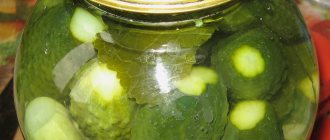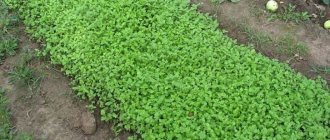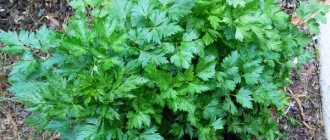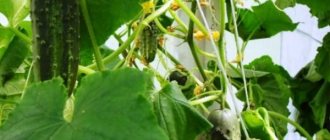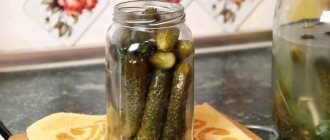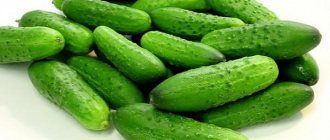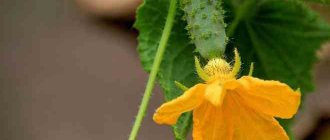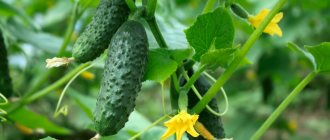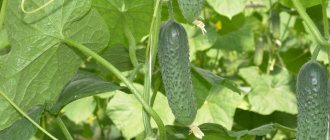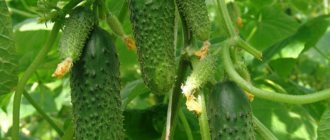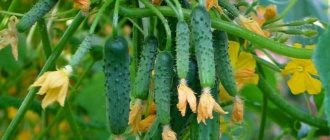Have you heard about such a wonderful vegetable as the Chinese cucumber? Let's take a closer look at its best varieties, which gardeners have already appreciated.
Chinese cucumber is a variety of the familiar cucumber. True, the fruits of this crop grow elongated and thin, reaching a length of 30 to 80 cm. And this is not all the features of the Chinese cucumber. It tastes sweeter and more aromatic (the flesh exudes the smell of watermelon or melon), and its skin is never bitter.
Chinese cucumbers are grown both in greenhouses and in open ground. They ripen well even in unstable weather in the middle zone, since many varieties are early ripening (only 25-35 days pass from germination to fruit formation). So, with proper care, you can collect up to 30 kg of tasty and unusual fruits from one bush. In addition, Chinese cucumbers are resistant to many cucumber diseases and are able to bear fruit until frost, even in the shade.
However, this “foreign” crop also has several disadvantages: the fruits do not last long, so they are best suited for salads, the seeds often germinate poorly, and when growing you have to tinker with the correct vertical garter, otherwise the cucumbers will grow ugly and hooked.
So, if you decide to try to grow such an unusual cucumber on your site, take a closer look at these varieties, which are intended for both greenhouses and unprotected soil.
Alligator F1
This is an early non-self-pollinating hybrid. On the strong bushes of these cucumbers, which grow very quickly, lumpy, rich green, cylinder-shaped fruits ripen until mid-October. They have excellent taste: very thin skin without bitterness, as well as juicy, sweet and aromatic pulp.
The name of this hybrid has become a household word, and now gardeners often call any long Chinese cucumbers alligators.
Chinese cucumber Alligator F1 is most often grown through seedlings. Seeds are sown in the first half of April, then in the phase of 2-3 leaves the seedlings are planted in separate containers, and at the age of 30 days (usually in the second half of May) they are transplanted into a greenhouse or open ground.
Alligator F1 cucumbers are resistant to most diseases, but sometimes the bushes can become infected with downy mildew.
| Purpose | Maturation (number of days after germination) | Fruit length (cm) | Fruit weight (G) | Productivity (kg per 1 sq.m.) | |
| 46-48 | 35-40 | 280-300 | 16-18 | ||
Description
It is difficult to imagine a person in Russia who would not know what a cucumber is. It is a Chinese variety, and the Chinese cucumber also belongs to the genus Cucurbitaceae, both by name and by most external features it is very similar to a regular one. In addition, care and many other agrotechnical measures are generally similar to those used for a regular cucumber. Nevertheless, the differences are also quite noticeable.
Peculiarities
The main difference between the Chinese cucumber is, of course, the length of the fruit. It ranges from 30 to 80, and often more, centimeters. The taste that Chinese cucumbers have is characterized by a slightly more pronounced sweetness with a slight aroma of watermelon or even melon.
There is no, and never is, bitterness in the Chinese cucumber, and the sweetest part is the skin of the fruit. There are practically no voids in its body, and the pulp is quite dense, somewhat reminiscent of wax in consistency.
Chinese cucumbers have a narrow chamber running through the center of the fruit, in which small-sized seeds are collected. The predominant flowers are female; they are usually collected in bunches of several pieces.
One of the attractive points, which is quite natural and understandable for Russian realities, is the high yield of Chinese cucumber - it can reach 30 kg from each plant bush with proper and competent care.
When developing currently widespread varieties, in most cases the task was to grow cucumbers in a greenhouse. The highest yield can be achieved in the closed conditions of a greenhouse or greenhouse. But, as practice has shown, the Chinese cucumber takes root well in open ground, demonstrating good fertility and the ability to produce a stable harvest not only in the southern regions of the country, but also much further north.
Another feature of the Chinese cucumber is its early ripening. Only about 30-35 days pass between germination and the collection of the first fruits, and sometimes even 25 days are enough. Considering the size of the fruit and the yield, for a full-fledged and regular salad during the season, 3-4 plants are enough for an ordinary family. And a planted bed can feed quite a significant number of people.
Some features of the topic under consideration are shown in the following video:
Advantages
To summarize the above, the following benefits of Chinese cucumber can be briefly highlighted:
- consistently high yield, which is characteristic of the plant throughout a long part of the season and continues almost until frost. It quite seriously exceeds the performance achieved by ordinary cucumbers;
- high resistance to the vast majority of diseases that affect cucumbers in domestic conditions. This quality, combined with unpretentiousness and undemandingness, greatly simplifies the cultivation of the crop in question;
- self-pollination, as a result of which there is no need for additional measures to attract bees;
- the ability to function normally in conditions of insufficient sunlight, in other words, shade tolerance. Some varieties develop even better in the shady parts of the garden, where sunlight rarely reaches;
- attractive appearance.
Flaws
Of course, with such undoubted advantages, the plant also has disadvantages. The main ones are the following:
- poor storage ability. The fruits of the Chinese cucumber are visually beautiful and attractive, but within a day after they are harvested they become soft and pliable under pressure. Therefore, it is advisable to consume or process the fruits of Chinese cucumber directly on the day of collection. Only a small part of varieties and hybrids are intended for canning and pickling;
- some restrictions on the method of consumption. Some varieties of Chinese cucumber can only be used for making salads. This drawback has many similarities with the previous one;
- relatively low seed germination rate. This minus is fully compensated by the high yield of those that did emerge;
- the necessity and obligation of a vertical bandage, that is, additional rather labor-intensive care. If this action is not carried out and the lashes are not tied, the fruits in most cases will grow into an extremely unattractive hook-shaped shape. The unconditional presence of specific and time-consuming work is partially compensated by the fact that the rest of the plants are extremely unpretentious and undemanding.
Growing
As noted above, the agricultural technology for growing Chinese cucumber generally coincides with conventional sowing. But there are several features.
Chinese cucumber, as a rule, forms one, but quite high - up to 3 meters, stem, practically without forming side shoots. And even if they appear, they are of a very short length. Therefore, you can plant a Chinese cucumber more often than a regular one.
Another feature of the plant is its requirement for watering. As a rule, an ordinary cucumber can easily tolerate missing this important event once. But Chinese cucumbers grow very, very quickly, so it is not recommended to skip watering, since almost immediately the plant will respond by forming a long and very thin fruit with many thorns, which, moreover, will most likely bend in an intricate way.
It is also necessary to pick the fruits in a timely manner (that is, almost daily). Otherwise, the “old” ones will increase more and more, acquiring, in general, monstrous sizes, and this will happen to the detriment of the young ovaries.
White delicacy
This variety was named for the skin color that is unusual for a cucumber: it is almost white, sometimes with a slight greenish tint. Compared to other Chinese cucumbers, the fruits of the White Delicacy are not very long (up to 15 cm), and are cone-shaped. Their peel and pulp are very tender, tasty and juicy.
Seeds are sown for seedlings in March, and at the age of 30 days they are transplanted into a greenhouse or into the ground under a film cover. Cucumbers of this variety easily tolerate worsening weather and are insensitive to sudden temperature fluctuations and changes in air humidity.
| Purpose | Maturation (number of days after germination) | Fruit length (cm) | Fruit weight (G) | Productivity (kg per 1 sq.m.) | |
| 45-50 | 12-15 | 90-120 | 12 | ||
Features of planting cucumbers
Growing vegetable giants is not difficult. The agricultural technology is identical to the algorithm for planting and caring for ordinary cucumbers. What needs to be done to get early and tasty green “snakes”.
Deciding on the variety and preparing the seeds
Before going to the store, it is better to immediately decide on the variety so as not to waste your time reading all the descriptions on the bags. It is important to carefully select a variety that will meet all growing conditions in a particular region.
It is enough to purchase 1-2 bags, since the cucumber gives a bountiful harvest, and just a few vines will provide seven crunchy vegetables. Some varieties are not suitable for pickling at all, so you should not replace your usual and favorite types of pickling cucumbers with Chinese ones.
Seeds need to be prepared for planting. This means soaking in water for germination. After a few days, the seed shells will hatch and you can begin planting seedlings or in a hole in outdoor beds.
Soil preparation
When growing cucumbers in a greenhouse, soil preparation is carried out in the fall. In greenhouse beds, two parts of sawdust, turf and 4 parts of humus are added to the soil. This substrate should be saturated with fertilizers, which consist of 10 liters of water with the addition of:
- saltpeter - 20 grams;
- wood ash - 250 grams;
- potassium magnesia - 15 grams;
- double superphosphate - 40 grams;
- urea - 10 grams.
With this autumn feeding of cucumbers, there is no need to fertilize the plants during the next growing season.
For open ground, it is not enough to simply dig a bed. You will also have to work hard here. Humus is mixed with straw and mixed with soil on the ridge. Spray thoroughly with water and cover with polyethylene. After a week, they begin sowing seeds.
Sowing seeds and germinating seedlings
It is quite easy to sow seeds in outdoor garden beds. Typically, a cucumber bed is made in the form of a trench with a furrow in the middle. Holes are made in this furrow at a distance of 20-25 cm, into which pre-sprouted seeds or germinated seedlings are placed. The earth is lightly patted with your hands and watered from a watering can.
There should be no other watering, as there is a risk of erosion of the soil and washing of seeds to the surface. The beds can be sprinkled with mulch.
The greenhouse will require seedlings. To grow it, they usually take cups with a diameter of up to 12 cm. It is better if they are peat. When planting later, the roots are not injured, since the cups are completely buried in the ground.
See also
How to make a cucumber bed in open ground with your own hands, types
Read
Seedlings are grown in the following way:
- The seeds are pickled in a solution of potassium permanganate and then dried.
- Fertile soil is poured into each cup, taken from a bed with prepared soil. Two seeds are planted in the ground in case one of them does not sprout. Planting depth 1 cm.
- The soil is well watered and covered with film. It is important to place the cups in a room where the temperature is about 30 degrees.
- After the cucumber shoots appear, the film is removed. The seedlings are watered and sprayed; they do not require any other care.
- If two cucumbers have grown in a pot, on the 15th day after emergence, one is removed, the flimsiest one.
- Cucumber seedlings are planted in a greenhouse from the 15th to the 30th day of growth.
It should be remembered that when calculating the distance between seedlings, it should be taken into account that the Chinese cucumber grows almost as one vine and produces little lateral growth. Therefore, it is enough to leave 20-30 cm between neighbors.
Timing for planting plants in the ground
Cucumber seeds are planted in open ground from May 1 to May 10, if the soil is warm enough and at night the temperature does not drop below +15 degrees. Otherwise, the deadlines will be shifted. These periods are different in different regions of Russia, so it is important to take into account climatic conditions.
It is always warm in the greenhouse, so the last ten days of April or the first days of May are suitable times for any region.
Even in rainy and cloudy weather it is always warm under the shelter. It is important to install a thermometer to monitor the temperature at the top of the greenhouse and in the soil. If the temperature drops, then special heating lamps are installed.
Emerald Flow F1
This is a parthenocarpic hybrid of Russian selection. The bushes grow tall, but trail weakly. The fruits are cylindrical, dark green in color. They have a thin peel, covered with numerous tubercles, and the flesh is very aromatic.
Seeds are sown for seedlings in mid-April, and planted in the ground when the threat of return frosts has passed (in a heated greenhouse - earlier).
The bushes of this hybrid do not suffer from powdery mildew, are insensitive to lack of light and temperature changes, and are not afraid of frost.
| Purpose | Maturation (number of days after germination) | Fruit length (cm) | Fruit weight (G) | Productivity (kg per 1 sq.m.) | |
| 44-48 | Up to 50 | Up to 200 | 6-8 | ||
Chinese snakes
These arched cucumbers are most often grown in heated greenhouses: this allows seedlings to be planted in protected soil in early May and a good harvest of long fruits to be harvested by the end of the month. The bushes are very powerful, branched, and produce crops for a long time. The fruits are dark green, with large but few tubercles.
| Purpose | Maturation (number of days after germination) | Fruit length (cm) | Fruit weight (G) | Productivity (kg per 1 sq.m.) | |
| 35-37 | 50-60 | 150-200 | 10-15 | ||
Advantages and disadvantages
Pros:
- heat resistance and fruiting at 35-37 degrees (at such temperatures other cucumbers stop setting);
- tolerance to drought conditions;
- uniform, significant productivity;
- resistance to a complex of dangerous pathogens;
- uniformity and marketability of greens;
- attractive appearance and excellent taste;
- extended fruiting until frost.
Minuses:
- short storage period (up to 7-10 days in the refrigerator).
Chinese heat resistant F1
As you might guess from the name, this hybrid is resistant to elevated temperatures (up to 35°C). The bush branches well, forms few stepsons and, as a rule, forms one main stem. The fruits are long, smooth, and shaped like a cylinder. Their thin skin is covered with large tubercles. The pulp is sweet and aromatic.
This Chinese cucumber is resistant to powdery mildew, downy mildew and fusarium wilt.
With the seedling method of growing, the seeds are sown in special containers throughout April, but you can sow directly into the ground - in the second half of May. In this case, the soil must warm up to 20-25°C, otherwise the seeds will not germinate. Therefore, in regions with a cool climate it will not be possible to do without film shelter.
| Purpose | Maturation (number of days after germination) | Fruit length (cm) | Fruit weight (G) | Productivity (kg per 1 sq.m.) | |
| 48-54 | 30-50 | Up to 300 | To 10 | ||
Chinese cold-resistant F1
This hybrid is suitable for growing in open ground (on trellises), in greenhouses and winter greenhouses. The bushes grow very quickly, the fruits ripen long, dark green, cylindrical in shape. The thin peel is strewn with numerous tubercles. The pulp is aromatic and very sweet.
This Chinese cucumber is cold-resistant, not afraid of frost, develops well in the shade, and resists powdery mildew and fusarium.
| Purpose | Maturation (number of days after germination) | Fruit length (cm) | Fruit weight (G) | Productivity (kg per 1 sq.m.) | |
| 50-55 | 30-50 | Up to 300 | To 10 | ||
